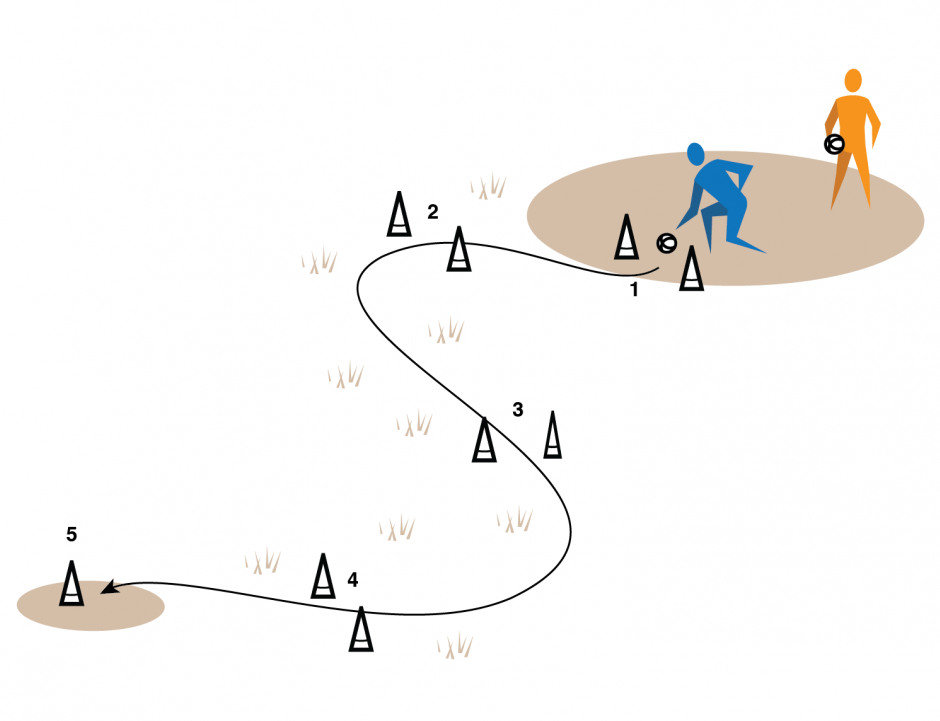TGfU Category: Target Games
Locations: gymnasium, multipurpose room, outdoor space (e.g., field, tarmac)
Game/Sport Connections
Target games are activities in which players send an object toward a target while avoiding any obstacles. By playing these games, participants develop skills and tactics to play other target games or games that require the application of similar skills, concepts, and strategies (e.g., archery, bocce, bowling, croquet, curling, golf, horseshoes, shuffleboard, Snow Snake).
Activity Overview
Participants learn about and practise accurately sending an object through a series of targets.
Key Movement Skills, Concepts, and Strategies
Throughout the activity, consider highlighting the following skills, concepts, and strategies for effectively sending an object through a series of targets. Note that this list is not exhaustive and further learning opportunities may arise during the task.
Movement Skills and Concepts
Manipulation skills and effort awareness: applying a controlled force to send an object toward the target (e.g., using different amounts of force depending on the distance from the target).
Movement Strategies
- Applying appropriate skills to be proficient when avoiding obstacles (e.g., choosing to manipulate the object with spins and turns in order to avoid obstacles).
- Learning to make decisions about the next play when playing against an opponent (e.g., hitting opponents’ object out of the way to make the activity more challenging for them).
Considerations
- Incorporate some or all of the variations listed in the “Variations” section while planning the activity. This will help to best meet the diverse backgrounds, identities, needs, and interests of participants and maximize the fun, inclusion, participation, and success of everyone.
- To elevate participant voice and choice, periodically pause the activity and share the variations with participants. Ask them to determine how they would like to change the activity to maximize the fun, inclusion, meaningful participation, and success for everyone. Encourage participants to add any variations of their own.
Equipment
- 1 object to send per participant (e.g., various sizes and textures of balls, beanbag, disc, rubber chicken)
- 9 floor markers per group to act as “gates” (e.g., rubber/vinyl spots, cones, pylons, chairs, tape)
Safety
- Inspect the equipment and activity area to identify and remove hazards. Check that the activity surface provides sufficient traction.
- Establish the boundaries for the designated playing area at a safe distance from walls and obstacles. Share the boundaries with participants.
- Review the safety rules and activity instructions with participants prior to the activity.
- Instruct participants to be aware of their surroundings, including the locations of other participants during play.
How to Play
- Divide participants into small groups (e.g., 2 – 6).
- Each group sets up a circuit of 5 “gates” in their designated activity space, using 8 pylons to create 4 gates (2 per gate) and 1 pylon for the final gate.
- Groups choose how far apart gates are from one another and the width of each gate.
- Each participant chooses an object to send (e.g., various sizes and textures of balls, beanbag, disc, rubber chicken) through the gates. Participants may change their object each time they have completed the circuit.
- One at a time, participants send their object (e.g., roll, kick while the object maintains contact with the ground, push) through the first gate.
- Participants take successive turns, sending their object from the spot where it had previously stopped. If a participant’s object is moved by another participant’s shot, the participant sends the object from the new location.
- Participants attempt to make it to the final gate in the least number of turns.
- Each participant continues in this manner until they have sent their object through each gate and their object strikes the final pylon.
- Participants attempt to be the first of their group to make it through all of the gates. Or, groups may work together to have the fewest number of rolls or kicks as a group.
- After a period of play, provide participants with some or all of the variations. Ask them to decide how they might change the game to enhance their fun, challenge, and success. Encourage participants to add any variations of their own.
- Consider having groups share their variations and select another variation to try with their group.
Image: Visual Depiction of the Activity Instructions

Pause for Learning
Throughout the activity, ask open-ended questions to help participants refine their movement skills, strategies, and tactical solutions. Examples include:
- What happens when you apply a strong force or a light force when sending your object toward a gate?
- When playing against other participants, how do you choose where to aim to get your object through the gate or aim to hit the other participants’ object out of the way?
- What strategy do you use to get ahead or to prevent the other participants from getting their object through the gate?
- Why is it important to be aware of your playing environment before choosing a sending object?
- Which games or sports have you played or know about that use similar rules and strategies to the ones used in this game?
Variations
- Make the gates wider by increasing the space between the two pylons.
- Work in pairs or as a group to successfully complete the circuit by taking turns sending the object through the gates.
- Make the gates narrower by decreasing the space between the two pylons.
- Send the object in different ways (e.g., roll/throw using their non-dominant hand, overhand throw, kick while the object maintains contact with the ground).
- Use an implement for striking (e.g., hockey stick, croquet mallet, pool noodle) to send the object through the gates toward the target while the object maintains contact with the ground.


